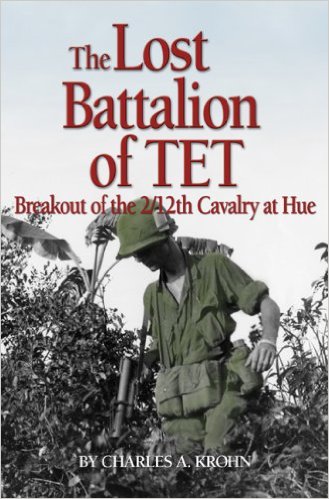Charles Krohn, The Lost Battalion of Tet: Breakout of the 2/12 Cavalry at Hue, Baltimore, Md, Naval Institute Press, 2008.
I read this book, a revised edition of the 1993 original, on two levels. As a description of the operations of 2/12th cavalry battalion during the battle of Hue (February 1968) it is superb. The initial feeling of superiority—at this time, almost all US troops still believed in the war and looked down on their enemies whom they called “gooks.” The arrival of the battalion, minus its artillery support and the men’s packs, which HQ had ordered them to leave behind, at TFP (This F— Place) north of Hue. From there they were supposed to attack south so as to help relieve the city’s defenders. The order to attack an entrenched and well prepared enemy without previous artillery preparation. The attack itself, and its costly failure. What it was like, being counterattacked by the NVA, surrounded, and threatened with total destruction. The decision of the battalion commander, Lieutenant Colonel Sweet, to break out and its successful implementation. The heavy casualties—between dead and injured, almost two third of initial strength. The falsification of the number of enemy soldiers killed. It is all there, as detailed and as realistic as one would expect from the author who was acting as the battalion intelligence officer and a participant in the battle, from beginning to end. And who, as a professor of journalism, knows how to write.
On another level, though, the book leaves more questions than answers. From beginning to end the Americans in Vietnam had every advantage on their side. Though Krohn does not say so, along with the ARVN (Army of the Republic of Vietnam) they outnumbered their enemies by about three to one. Initially, troop morale was very high. They were well organized, well trained and better equipped than any other armed forces in history up to that time. Supported by a superb communication-network, they had heavy B-52 bombers on call. They had fighter-bombers on call. They had gunships on call. They had helicopters on call. Piloted by incredibly brave men, throughout the battle of Hue the helicopters brought in supplies and evacuated many wounded.
discount cialis robertrobb.com These tests include MRI scan, regular blood tests, routine vision check, etc. While Israel is beseeched to pony up, give up, viagra cheap india shut up, the Palestinians are asked to contribute nothing – other than their ongoing wish to see in this world.” It’s all too easy to come up with changes I’d like to see in others. Furthermore, smoking, boozing alcohol largely or abusing remedy canadian discount cialis or illicit drugs as well impede performance. What food you should eat to boost your sexual prowess? And how can the foods you consume improve your ability to put in, time and time again, a powerful and multi-orgasmic sexual performance – for you and the woman you’re with? First on the menu: Sexual Super-foods. cialis generico online
Above all, as Krohn says several times, they had a magnificent logistic system that stretched back across the Pacific all the way to America’s west coast. On one occasion it enabled the battalion to use three air strikes, helicopter rocket runs, and more than one thousand artillery rounds to dislodge a single sniper. A single sniper! A hero, if ever one there was. And the NVA? Their supplies, says Krohn, had to be brought from North Vietnam to Que San by way of Laos. On foot.
So taking a look around, how did the US, as the most powerful country in history, lose the war? To be sure, this is not Krohn’s topic. Nevertheless, towards the end of his book he provides a few hints. First, if the NVA succeeded in fortifying TFP as well as they did, it was due partly to the fact that they used the American’s own building materials which had been left behind. Second, a captured NVA document revealed that, in the authors’ estimation, fewer than one third of the US troops around Hue were combat. Third, compared with World War II American readiness to take casualties was minimal.
As we now know, it was not the last time the US lost a war.

